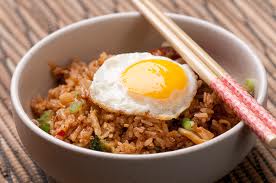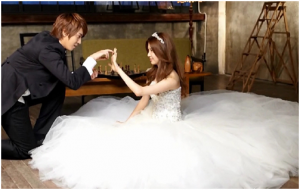Top 10 things to do with children in Northern Thailand
1. Ride an elephant
There are more than 20 elephant parks close to Chiang Mai. Enjoy bamboo river rafting, watch the elephants play soccer and paint, take a lumbering elephant trek or even a traditional ox-cart ride. See maetamanelephantcamp.com
2. Visit the Night Bazaar
Crowded pavements make stroller access difficult but children who can bear walking for an hour or so will enjoy the action. For dinner, try Lemongrass restaurant on Loi-Kroh Rd.
3. Take time out in a café.
A family could try out a new coffee house or café every day for a year in Chiang Mai. Children will love the coconut milk or fruit-based smoothies which cost $1-$2.
4. Eat Thai Style
Explore Warorot, Sanpakoi or Somphet markets for fresh fruit, delicious local sticky rice and other goodies. Find a stall selling Som Tam (Salty and sweet papaya salad). Plain sticky rice suits fussy children – ours loved spring rolls and soups, grilled lemongrass chicken and pork buns. Say “mai sai prihk” – no chilli – and “mai sai pong chulot” – no MSG.
5. Tweechol Botanic Garden
Fill an afternoon at this recreational park with paddle boats, giant whimsical topiary animals, a petting zoo and bikes for hire. There is a café playground and beautiful public swimming pool on site. About $15. See tweecholbotanicgarden.com.
6. Handicraft villages
Our girls were fascinated by traditional “saa paper” being made from bark pulp, then transformed into the beautifully painted parasols for which the Bo Sang region is famous. Other handicrafts showcased and sold in the area include silk, silver, rugs and teak furniture. See absolutelyfantasticholidays.com
7. Chiang Mai Night Safari
Families can pat exotic animals such as white tigers and Malagasy lemurs, then ride on open-air buses to watch and feed hippopotamus, elephants, zebras and other animals. From $55 for a family of four. See chiangmainightsafari.com
8. Chiang Mai Zoo
A sprawling, clean affair, with a diverse combination of animals. About $10 a family of four, more to see the pandas, walk South-East Asia’s longest tunnel aquarium or have a mid-Thailand “snow” experience. See chiangmaizoo.com
9. Mae Klang Waterfall
About 30 minutes’ drive from the city. Safe and clean for a free afternoon of paddling in rock pools with local kids.
10. Trek to visit the hill tribes
An authentic trekking experience that suits families rather than 20-year-old backpackers is available through Villa Anneloi. Stay at the B&B or with Belgian Annelore and her husband, Loi, who is from the local Karen hill tribe, and their three boys in a homestay environment. Custom-tailored camping treks for families with children from four years. See villa-anneloi.com
Source: escape.com.au
Some Stories About Our Japanese Course 14
(Blog writing)
Hi everyone, 皆さん、こんにちは。
My Japanese classes and lessons included the usual kinds of activities that aim to develop speaking, reading, listening, writing, constructing and performing dialoguesor speech apart from cultural, society-orientated about Japan.
In terms of script learning, I requested a couple of Beginners 1 classes to make Hiragana-based flash cards. The cards could be each letter based or word based and they could have pictures too, depending on the students’ preferences. Most of the students of one of the classes made flash cards with great creativity, diligence, neatness and beauty on top of linguistic value. That was very appreciated and delightful.
As for singing Japanese songs for language and culture learning and making one’s tongue and mouth getting ready for Japanese (foreign) language learning, I introduced a few new songs in addition to the children’s songs that I had taught in the past this year.
The new songs are (late) Kyuu(or Kyu) Sakamoto’s “Ue –o MuiteArukoo”. Its English translation is “Sukiyaki” that does not have any relation in meaning, according to a website, http://www.dailymotion.com/video/xj3zg_kyu-sakamoto-sukiyaki_music. The website has Romaji translation of the famous song, which is internationally very well known, having become a Number 1 music hit on the charts in America many years ago. In Australia too, I occasionally heard it on the major radio station (3MP?, which is the music station) in Melbourne. The website has English translation too.
Also I taught aboveKyuu Sakamoto’s other song with CD (one from Japan Foundation), “Tomodachi” (“Friends”) with my English translation and word-processed Japanese script version. Kyuu Sakamoto was extremely popular when he was alive and active in singing and performing in entertainment. Sadly, he died due to an aircraft clash in 1985. Above both songs are very compassion and warmth promoting/creating ones for any anyone and esp. for those who are lonely or hurt/sad. The latter one is also very positive, broad visions creating, and enriching humanities.
There are “many” of such songs among Japanese popular songs that always touch and help people’s life, emotions, relationships, positive attitudes, sensitivity toward small ones or fragile ones (including creatures other than humans), and communal attitude and value in Japan.
Pertaining to technology, international relations concerned, I informed my classes about the article, “Japan ties ‘key to growth’” by Rick Wallace, The Australian (8.10.12, pp. 19-20). A very good article to read.Also, with that newspaper’s magazine, “Motor Show”, I talked about Japanese car manufactures’ active participations to the Motor Show at Sydney Convention and Exhibition Centre last month (19-28 October). Out of about 24 car makers there, 8 are Japanese companies. Very exciting news.
In the recent Jenta magazine, it says that over 270,000 people climbed Mt Fuji during July and August this year. That was 30,000 more people than last year’s same period.
That is delightful news too.
Japanese Teacher, Toshiko Jackson
2.11.12
The king of Korean Home Food “ Kimchi Fried Rice (Bokeumbap)” Recipes
Kimchi Fried Rice (Bokeumbap) is humble food that is mostly enjoyed at home, but you might also see it in some casual Korean eateries. At home, it’s a great way to use leftover kimchi that’s a bit past its prime. Quick, easy, and cheap to make, kimchi bokeumbap is simple Korean home cooking at its best.
Prep Time: 5 minutes
Cook Time: 15 minutes
Total Time: 20 minutes
Ingredients:
- 1 cup kimchi, drained and chopped (preferably a bit old and sour Kimchi)
- 1/2 sweet onion, chopped
- 1 Tbsp soy sauce
- 1 Tbsp butter
- 1/3 cup thinly sliced beef/ spam/ pork/ bacon/ tuna or ham
- 3 cups cooked rice
- Salt to taste
- 1 Fried egg for each serving
Preparation:
- If using bacon, saute briefly on an ungreased large pan and omit oil from next step. With any other meat or a vegetarian version, start with step #2.
- Saute kimchi and onion in a lightly greased large pan over medium heat for a few minutes.
- When vegetables begin to look transparent, add ½ Tbsp of butter, garlic, and soy sauce and saute for another 2-3 minutes.
- Add meat or pork and continue to saute until meat is cooked.
- Turn heat off but keep pan on burner.
- Add rice and rest of butter, mixing to combine.
- Salt to taste and top with fried egg to serve.
(Serves 4)
North–South differences in the Korean language
There are a small number of differences in the standard forms of the Korean language used in the Democratic People’s Republic of Korea (North Korea; hereafter “the North”) and the Republic of Korea (South Korea; hereafter “the South”), due to the length of time Korea has been divided.
1. Letters: The same Hangeul letters are used to write the language in the North and the South. However, in the North, the stroke that distinguishes ㅌ |tʰ| from ㄷ |t| is written above rather than inside the letter as in the South.
|
Letter |
North Korean name |
South Korean name |
|
ㄱ |k| |
기윽 [kiɯk̚] | 기역 [kijʌk̚] |
|
ㄷ |t| |
디읃 [tiɯt̚] | 디귿 [tiɡɯt̚] |
|
ㅅ |s| |
시읏 [ɕiɯt̚] | 시옷 [ɕiot̚] |
|
ㄲ |k͈| |
된기윽 [tøːnɡiɯk̚] | 쌍기역 [s͈aŋɡijʌk̚] |
|
ㄸ |t͈| |
된디읃 [tøːndiɯt̚] | 쌍디귿 [s͈aŋdiɡɯt̚] |
|
ㅃ |p͈| |
된비읍 [tøːnbiɯp̚] | 쌍비읍 [s͈aŋbiɯp̚] |
|
ㅆ |s͈| |
된시읏 [tøːnɕiɯt̚] | 쌍시옷 [s͈aŋɕiot̚] |
|
ㅉ |tɕ͈| |
된지읒 [tøːndʑiɯt̚] | 쌍지읒 [s͈aŋdʑiɯt̚] |
2. Pronunciation: The standard languages in the North and the South share the same types and the same number of phonemes, but there are some differences in the actual pronunciations. The South Korean standard pronunciation is based on the dialect as spoken in Seoul, but the North Korean standard pronunciation is based on the dialect as spoken in Pyongyang.
3. Emphasis: In the North, names of leaders 김일성 (Kim Il-sung), 김정일 (Kim Jong-il) and 김정은 (Kim Jong-un) are always set off from surrounding text, typically by bolding the characters or increasing the font size.
Reference
Jochen-Martin Gutsch (2012), Germans Give Pep Talks on Korean Unification Der Spiegel .
Learning Korean from Korean T.V show
We got married! 우리 결혼했어요 (우결)
We Got Married (우리 결혼했어요) is one of the popular variety shows on MBC. The show is directed for the purpose of how couples of Korean celebrities could show what life would be like if they were married. Each week, couples are assigned missions to complete, with candid interviews of the participants to reveal their thoughts and feelings. The variety show tells you how young couples would solve the troubles of their love and marriage throughout the interesting episodes.
The show, 우리 결혼했어요, let us think of some interesting questions which everyone would have ever thought about once such as “If I were ~ or If we are” While you watch the show, you may be confused what is real or imaginary. Now, the season 4 is still going on since the first season started in 2008. In the season 4, you can enjoy exciting episodes between new couples, Jullien Kang & 윤세아, 황광희 & 한선화 (one of members of Secret), 이준 & 오연서. Nowadays, 황광희, one of the member of ZE:A, is a budding rookie in many reality variety shows.
Shall we learn Korean past tense from the show title?
The sentence, 우리 결혼했어요, means “We got married”. It is a past tense. How to say something of what you did in Korean?
Before you move on to the next step, you need to know the structure of the Korean verbs first. All Korean verbs end in –다 such as 보-다(to see, watch), 먹-다(to eat), and 공부하-다(to study). Korean verbs are divided into two parts, stem part and ending part. The ending part is always –다. In the word, 공부하다, 공부하 is a stem part and –다 is an ending part.
Korean past tense can be made with –았어요/-었어요/-했어요. Depending on the vowel in the last syllable in each verb stem, -았어요, -었어요 or –했어요 should be attached to the stem part. At this time, -다 ending part is deleted.
If the last syllable in any verb stem has a ‘ㅏ’ or ‘ㅗ’ vowel, -았어요 is added. For example, you can separate the verb 보다 (see, watch) into 보 and 다. 보-(stem part) has a ‘ㅗ’ vowel, so –았어요 is added. Then without –다, 보 is combined with –았어요. So it becomes 보-았어요. It means ‘saw’.
To another verbs has other vowels excepting ‘ㅏ’and ‘ㅗ’ in the last syllable in the stem, -었어요 is combined. For example, 먹-다 which means eat, has a ‘ㅓ’vowel in its stem. So the stem part can put together with –었어요. Finally, 먹 and –었어요 become 먹었어요 which means ate.
All verbs ending in하다 become –했어요. For example, 공부하다(study) becomes 공부했어요 (studied). As you seen the title of ‘우리 결혼했어요’, 결혼했어요 comes from the basic form ‘결혼하다 (get married)’. You can use the expression ‘-했어요’ in many ways. It means “I did something”.
저는 한국어 공부했어요. (I studied Korean/ Jeoneun hangugeo gongbuhaetsseoyo)
저는 비빔밥 먹었어요. (I ate 비빔밥/ Jeoneun bibimbop meogeotsseoyo)
저는 영화 보았어요. (I watched a movie/ Jeoneun yeounghwa boatsseoyo).
Question form is simple.
“어제 뭐 했어요?” It means “What did you do yesterday?” 어제[eoje] means “yesterday”.
You can make your own answers. 저는 어제 한국어 공부했어요. Instead of 한국어, you can put anything.
저는 (math) 공부했어요. 저는 (불고기) 먹었어요. In the bracket, you may put anything.
Ok. Just enjoy learning Korean and try to use what you learn. Thank you.
Korean teacher, Sarah Yong.






Latest Comments